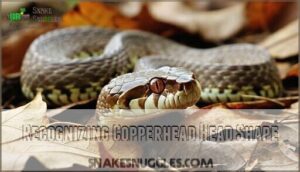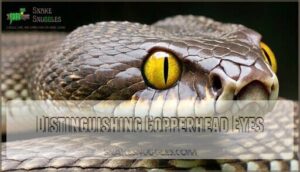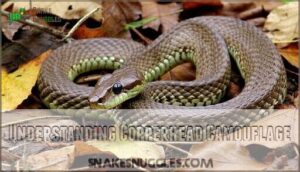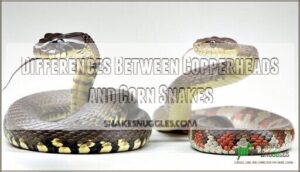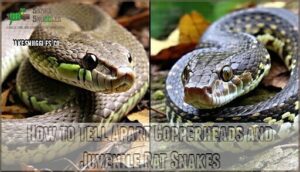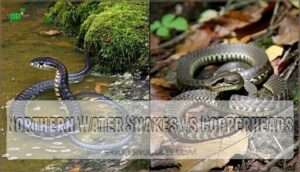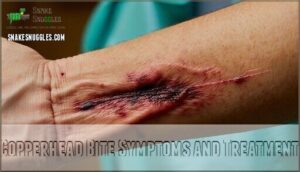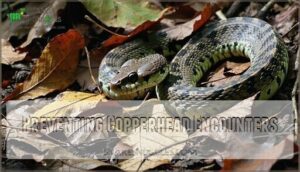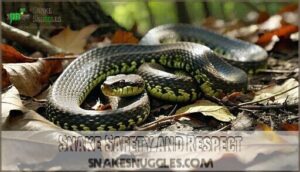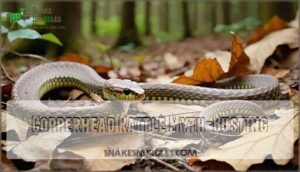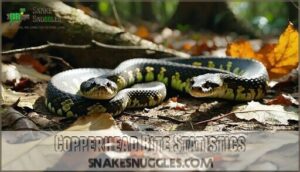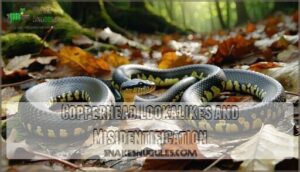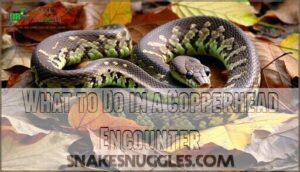This site is supported by our readers. We may earn a commission, at no cost to you, if you purchase through links.
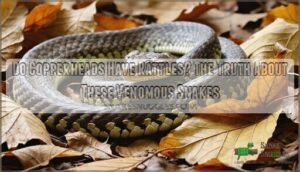
Copperheads rely on their excellent camouflage and freeze-in-place tactics when threatened. They might vibrate their tail against leaves to create a buzzing sound, but there’s no actual rattle attached.
This tail-shaking behavior often confuses people into thinking they’ve spotted a rattlesnake. Copperheads have triangular heads, heat-sensing pits, and distinctive hourglass patterns across their copper-colored bodies.
Their bite is venomous but rarely fatal to humans. Understanding these key differences can prevent dangerous misidentification and help you recognize what you’re actually dealing with in the wild.
Table Of Contents
- Key Takeaways
- Copperhead Identification Tips
- Copperhead Vs Similar Species
- Copperhead Behavior and Habitat
- Copperhead Bite Symptoms and Treatment
- Preventing Copperhead Encounters
- Snake Safety and Respect
- Copperhead Rattle Myth-Busting
- Copperhead Bite Statistics
- Copperhead Lookalikes and Misidentification
- What to Do in a Copperhead Encounter
- Frequently Asked Questions (FAQs)
- Are Copperheads aggressive?
- What is the difference between a Copperhead and a rattlesnake?
- Do Copperheads have a rattle?
- Do Copperheads eat rattlesnakes?
- Do rattlesnakes outgrow Copperheads?
- Are Copperhead rattlesnakes dangerous?
- What snake is mistaken for a copperhead?
- Which is more aggressive, copperhead or rattlesnake?
- Can copperheads rattle?
- Can copperheads make a rattling sound?
- Conclusion
Key Takeaways
- Copperheads don’t have rattles – You’re thinking of rattlesnakes, their pit viper cousins, but copperheads rely on camouflage and freezing instead of warning sounds.
- They can mimic rattling sounds – You’ll hear copperheads vibrate their tails against dry leaves to create buzzing noises that fool people into thinking they’ve spotted a rattlesnake.
- You can identify them by key features – Look for triangular heads wider than their necks, copper-colored bodies with dark hourglass patterns, vertical pupils, and heat-sensing pits between their eyes and nostrils.
- Their bites are venomous but rarely fatal – You’ll need immediate medical attention if bitten, but copperhead venom causes tissue damage rather than death when treated promptly.
Copperhead Identification Tips
You can identify copperheads by their distinctive triangular heads that are wider than their necks, plus their copper-colored skin with dark hourglass patterns.
Their cat-like vertical pupils and heat-sensing pits between their eyes and nostrils make them easy to distinguish from harmless snakes with round pupils, which is a key factor in identifying copperheads.
Recognizing Copperhead Head Shape
When identifying a copperhead snake, focus on its distinctive triangular shape head that’s markedly wider than the neck.
This head size difference accommodates venom glands.
Look for the characteristic coppery-tan coloration and facial pits between the eyes and nostrils – key copperhead identification features.
The vertical, elliptical pupil shape resembles a cat’s eye, distinguishing it from harmless snakes with round pupils during snake identification.
Identifying Copperhead Body Patterns
Beyond the distinctive triangular head, copperhead snake identification relies heavily on recognizing their signature body patterns.
These venomous snakes display remarkable consistency in their markings across different regions.
- Hourglass Pattern: Dark crossbands narrow at the spine and widen toward the belly, creating the classic hourglass shape that distinguishes copperheads from other species.
- Juvenile Markings: Young copperheads show brighter, more contrasted patterns with vivid yellow tail tips used for prey attraction.
- Color Variations: Regional differences produce subtle shifts from pale tan to pinkish-brown backgrounds with consistent dark banding.
- Scale Patterns: Smooth, overlapping scales enhance the camouflage effect, making snake identification challenging in natural leaf litter environments.
Distinguishing Copperhead Eyes
When examining a copperhead snake, you’ll notice distinctive cat-like eyes that set them apart from harmless species.
These venomous snakes have bright yellow irises surrounding vertical, elliptical pupils – quite different from the round pupils of nonvenomous snakes.
| Eye Feature | Copperhead Characteristic |
|---|---|
| Pupil Shape | Vertical, elliptical |
| Iris Color | Bright yellow |
| Eye Position | Forward-facing with heat pits nearby |
This eye structure gives copperheads excellent visual acuity for hunting, while the nearby heat pits help them detect warm-blooded prey in complete darkness.
Understanding Copperhead Camouflage
After spotting those distinctive cat-like eyes, you’ll need to understand how copperheads vanish before your eyes.
These nonrattlesnakes are ambush predator tactics experts, using their natural camouflage to become nearly invisible. Their coppery-tan coloration perfectly matches autumn environments, while dark hourglass crossbands break up their body outline against leaf litter camouflage.
Copperhead snake identification becomes tricky because they’re habitat blending masters:
- Leaf Litter Camouflage – Their colors mirror dead leaves, bark, and forest debris
- Seasonal Color Changes – Adults shift between lighter and darker tones throughout the year
- Juvenile Camouflage – Young copperheads have brighter yellow tail tips but similar body patterns
- Ambush Predator Tactics – They remain motionless for hours, waiting for prey
- Habitat Blending – Perfect camouflage in woodpiles, rock crevices, and garden areas
When threatened, copperheads freeze completely, relying on this natural camouflage rather than fleeing like other snake species.
Copperheads rely on perfect stillness and camouflage instead of fleeing when danger approaches.
Copperhead Vs Similar Species
You’ll often encounter snakes that look surprisingly similar to copperheads, making proper identification essential for your safety.
Learning the key differences between copperheads and harmless species like corn snakes, juvenile rat snakes, and northern water snakes can prevent dangerous misidentification in the field.
Differences Between Copperheads and Corn Snakes
You can easily tell copperheads apart from corn snakes by focusing on key differences.
Copperheads show triangular heads and hourglass-shaped crossbands, while corn snakes display narrow heads with square-like blotches.
One key identifier is that copperheads possess heat-sensing pits, which corn snakes lack.
| Feature | Copperhead | Corn Snake |
|---|---|---|
| Head Shape | Triangular, wider than neck | Narrow, elongated |
| Body Patterns | Dark hourglass crossbands | Square red blotches |
| Venom Status | Venomous pit viper | Harmless constrictor |
How to Tell Apart Copperheads and Juvenile Rat Snakes
While juvenile rat snakes can fool you with their blotched patterns, key differences help distinguish them from copperheads.
Head shape provides the clearest clue—copperheads sport triangular heads that are distinctly wider than their necks, while rat snakes maintain narrower, more uniform head widths.
| Feature | Copperhead | Juvenile Rat Snake |
|---|---|---|
| Pupil Shape | Vertical slits | Round pupils |
| Body Pattern | Hourglass bands | Irregular blotches |
| Tail Tip | Plain colored | Often yellowish |
Scale patterns tell another story. Copperheads display consistent hourglass-shaped crossbands, whereas juvenile rat snakes show random blotchy markings.
Behavioral differences matter too—copperheads freeze when threatened, but rat snakes typically flee quickly. Since habitat overlap occurs frequently in wooded areas, proper snake identification becomes essential for safety.
Northern Water Snakes Vs Copperheads
When comparing the Eastern Water Snake with the venomous copperhead snake, habitat overlap creates identification challenges.
These species share similar environments, leading to markings confusion among observers.
| Feature | Northern Water Snake | Copperhead |
|---|---|---|
| Head Shape | Narrow, less distinct | Triangular, broad |
| Pattern | Dark blotches, irregular | Hourglass crossbands |
| Habitat | Near water sources | Wooded, rocky areas |
| Behavior | Aggressive when cornered | Freezes, relies on camouflage |
Behavior comparison reveals water snakes are more defensive, while copperheads prefer remaining motionless.
Venom differences matter most—water snakes aren’t venomous despite their intimidating appearance.
Copperhead Behavior and Habitat
Understanding copperhead behavior helps you stay safe when you’re exploring their natural habitats. These snakes prefer specific environments and show predictable patterns that you can learn to recognize and avoid.
Understanding Copperhead Aggression Levels
Understanding copperhead snake aggression starts with recognizing these snakes rarely attack unless provoked.
Copperheads exhibit defensive behaviors primarily when directly threatened, stepped on, or cornered. Their bites are rarely fatal to humans because their venom isn’t very potent.
- Bite frequency remains low – studies show most copperheads freeze rather than strike when encountering humans
- Strike distance typically extends only one-third of their body length during defensive behavior
- Venom metering occurs frequently, with many bites delivering little to no venom
Copperhead Activity Patterns and Temperature Preferences
Beyond their generally calm temperament, copperhead behavior shifts dramatically with changing seasons and temperatures.
These cold-blooded reptiles become nocturnal during hot summers but switch to diurnal activity when temperatures cool.
Their ideal temperatures range from 70-85°F for peak activity.
| Season | Activity Pattern | Temperature Range | Behavior Focus |
|---|---|---|---|
| Spring | Diurnal | 60-75°F | Den emergence, mating |
| Summer | Nocturnal | Above 80°F | Hunting, shelter-seeking |
| Fall | Mixed | 50-70°F | Foraging, den return |
| Winter | Inactive | Below 50°F | Hibernation |
Seasonal activity patterns drive habitat selection as copperheads seek basking spots during cooler months and shaded retreats when heat peaks.
This temperature-driven snake behavior explains why you’ll rarely spot them during extreme weather conditions.
Common Places to Find Copperheads
Copperheads frequent diverse environments across their range.
You’ll find them in:
- Wooded areas with dense leaf litter for camouflage
- Rocky outcrops and hillsides offering shelter and basking spots
- Swampy regions and forest edges near water sources
- Populated areas including yards, woodpiles, and abandoned buildings
These adaptable snakes thrive in ecotones where different habitats meet, making encounters possible even in suburban settings.
Copperhead Bite Symptoms and Treatment
If you’re bitten by a copperhead, you’ll likely experience pain, swelling, and discoloration around the bite site within minutes to hours.
While copperhead bites are rarely fatal to healthy adults, immediate medical attention is essential for proper treatment and monitoring of symptoms.
Recognizing Copperhead Bite Symptoms
After understanding copperhead behavior and habitat, recognizing bite symptoms becomes essential for your safety.
A copperhead bite typically produces immediate, intense pain at the wound site. Initial symptoms develop rapidly and shouldn’t be ignored.
Watch for these key warning signs:
- Severe localized pain and rapid swelling around the bite area
- Redness and bruising that spreads from the puncture wounds
- Nausea or metallic taste in your mouth as venom effects begin
Snake bite symptoms from copperhead venom require immediate medical assessment, regardless of bite severity perceived. Bites may necessitate antivenom, but treatment can be costly.
Understanding Dry Bites and Venom Injection
Not all copperhead bites inject venom. About 25% are dry bites with zero venom injection, thanks to the snake’s precise injection control.
This venom metering means bite severity varies dramatically, making snake bites unpredictable.
| Bite Type | Venom Amount | Typical Symptoms |
|---|---|---|
| Dry Bite | 0 mg | Pain, minor swelling |
| Mild Bite | 5-15 mg | Localized pain, moderate swelling |
| Moderate Bite | 16-25 mg | Significant swelling, bruising |
| Severe Bite | 26+ mg | Systemic effects, extensive tissue damage |
| Average Bite | 26 mg | Localized symptoms, rarely fatal |
Copperhead venom composition includes hemotoxins that destroy tissue, but most bites cause manageable symptoms when treated promptly. The presence of systemic effects can indicate a more severe bite, and understanding venom composition is key to treatment. Effective treatment relies on recognizing localized symptoms.
Effective Treatment Options for Copperhead Bites
Medical professionals recommend immediate treatment for copperhead bites to prevent tissue damage and manage pain effectively.
First aid includes keeping the affected area still and removing jewelry before swelling begins.
Antivenom efficacy proves most reliable for moderate to severe reactions, while pain management helps patients cope with discomfort during recovery.
- Swift medical care prevents lasting tissue damage from copperhead venom
- Proper snake bite treatment reduces your risk of long-term effects
- Expert pain management keeps you comfortable during healing
- Professional bite aftercare guarantees complete recovery from snake bites
Preventing Copperhead Encounters
You’ll want to take smart precautions when spending time in areas where copperheads live, especially during their active seasons.
By understanding their preferred hiding spots and using proper protective gear, you can substantially reduce your chances of an unwanted encounter with these well-camouflaged snakes.
Safety Precautions for Outdoor Activities
Outdoor adventures become safer with smart protective gear choices.
Wear long pants, boots, and long sleeves when hiking through copperhead territory.
Stay on marked trails for trail safety, avoiding tall grass and leaf litter where these venomous snakes hide.
Use flashlights after dark and carry emergency contacts for snake bite prevention and quick first aid response.
Avoiding Copperhead Habitats and Hiding Spots
Smart yard maintenance keeps you safe from copperhead encounters.
Remove woodpile stacks, rock pile hazards, and excess leaf litter where these snakes hide. Trim overgrown vegetation regularly and seal foundation cracks.
Copperhead habitat includes wooded edges near water sources, so focus garden safety efforts around these snake locations within their natural copperhead range.
During the day, they often seek shelter under rocks and logs.
Importance of Wearing Protective Clothing
Beyond avoiding copperhead habitats, proper clothing provides your best defense against snake bites.
The right clothing material and coverage area can prevent dangerous encounters from becoming medical emergencies. Consider investing in specialized snake protection for enhanced safety.
- Sturdy boots and long pants – Essential snake bite safety gear that covers vulnerable areas like ankles and shins
- Thick fabric materials – Denim or canvas offers better bite resistance than thin materials during outdoor activities
- Seasonal wear considerations – Lighter protective layers work for summer hikes while maintaining snake bite prevention strategies
- Activity-specific gear – Choose appropriate snake safety equipment based on whether you’re hiking, gardening, or camping
Snake Safety and Respect
Respecting venomous snakes like copperheads means keeping your distance and staying alert when you’re outdoors.
If you encounter any snake, don’t try to handle it or get closer for a better look – even experts can make deadly mistakes.
Being Aware of Your Surroundings
Your awareness on trails can mean the difference between a peaceful hike and a dangerous encounter. Trail Awareness requires Visual Scanning of your path ahead, especially where Copperhead habitats overlap with popular routes.
Remember to prioritize essential hiking equipment when venturing into snake-prone areas.
| Environment | Key Observation Points |
|---|---|
| Wooded trails | Leaf litter, fallen logs |
| Rocky areas | Crevices, sun-warmed stones |
| Water sources | Stream banks, pond edges |
| Clearing edges | Brush piles, debris |
| Campsites | Gear storage, tent areas |
Practice Habitat Observation by noting prime Snake Habitat features. Sound Detection helps too—listen for rustling that might indicate Snake Behavior.
Maintain Safe Distances from suspicious areas where Venomous Snakes could hide.
Avoiding Unnecessary Interactions With Snakes
Most snakes want nothing to do with you, and copperheads are no exception. Smart snake behavior means respecting their space and avoiding unnecessary drama.
Here’s how to stay out of trouble:
- Practice trail awareness by scanning the path ahead, especially around logs and rocks where copperheads hide
- Maintain safe distances of at least six feet when you spot any snake, whether it’s a copperhead vs rattlesnake situation
- Modify habitat around your home by removing brush piles and keeping grass short to discourage snake encounters
Seeking Medical Attention for Snake Bites
If you’re dealing with any snake bite, time matters. Get to a hospital immediately where medical professionals can assess venom effects and provide antivenom options if needed.
Don’t waste time with home remedies or waiting to see what happens.
| Immediate Actions | Hospital Procedures | Bite Aftercare |
|---|---|---|
| Call 911 or drive to ER | Blood tests and monitoring | Follow wound care instructions |
| Keep bite below heart level | IV fluids if needed | Watch for infection signs |
| Remove jewelry/tight clothing | Pain management protocols | Attend follow-up appointments |
| Stay calm and still | Tetanus shot evaluation | Monitor for long-term effects |
| Note snake appearance | Antivenom administration if severe | Physical therapy if mobility affected |
Copperhead bites rarely require antivenom, but proper medical evaluation guarantees you receive appropriate snake first aid and treatment for your specific situation.
Copperhead Rattle Myth-Busting
You’ve probably heard people claim that copperheads rattle their tails just like rattlesnakes, but this common belief isn’t quite accurate.
While copperheads don’t actually have rattles, they can create a rattling sound that often fools people into thinking they’re dealing with a different type of venomous snake.
Can Copperheads Make a Rattling Sound?
Copperheads don’t have rattles and can’t make true rattling sounds.
When threatened, they’ll vibrate their tails against dry leaves, creating leaf rustling that mimics rattlesnake warnings.
This tail vibration serves as mimicry defense, fooling predators into thinking they’re facing a dangerous rattlesnake.
While this rattle deception creates audible warnings, it’s just clever bluffing—not actual snake sounds from a rattle structure.
Why Copperheads Are Often Mistaken for Rattlesnakes
Throughout North America’s wooded regions, you’ll encounter a classic case of mistaken identity between copperheads and rattlesnakes.
This confusion happens because these pit vipers share striking similarities that fool even experienced hikers.
Here’s why copperhead vs rattlesnake identification trips people up:
- Pattern similarity: Both species display diamond-shaped markings and triangular heads, making quick visual identification challenging in natural settings.
- Habitat overlap: These snakes coexist in similar environments, increasing encounter opportunities and misidentification rates.
- Defensive behavior mimicry: Copperheads perform tail vibration against dry leaves, creating rattling sounds without actual rattles, perfectly mimicking rattlesnake warnings.
Snake mimicry works because juvenile confusion also plays a role—young copperheads’ behaviors closely resemble adult rattlesnakes.
Copperhead Bite Statistics
Understanding copperhead bite statistics helps you assess the real risks these snakes pose in different areas.
You’ll find that bite incidents vary substantially by region and season, with some months showing much higher numbers than others, which can be crucial for understanding the risks.
Number of Copperhead Bites Per Month
Understanding bite seasonality helps you stay prepared during peak danger months.
Copperhead snake bite incidents surge between May and September, with approximately eight bites occurring daily nationwide.
Monthly averages show reporting trends peak during warmer months when these venomous snakes become most active.
| Month | Average Bites | Peak Activity | Bite Severity | Risk Level |
|---|---|---|---|---|
| May | 380 | High | Moderate | Elevated |
| June | 420 | Highest | Severe | Critical |
| July | 410 | High | Moderate-Severe | Critical |
| August | 350 | Moderate | Moderate | High |
| September | 320 | Declining | Mild-Moderate | Moderate |
Snake bite risks correlate directly with temperature increases and outdoor activity patterns.
If a dog is bitten, immediate veterinary care is essential for survival.
It is crucial to understand the peak danger months and take necessary precautions to avoid venomous snakes.
Regions With High Copperhead Bite Incidents
Across the southeastern United States, certain bite hotspots see higher copperhead snake bite incidents due to regional factors like population density and environmental changes.
Medical access varies substantially between rural and urban areas.
| State | Annual Bites | Peak Season |
|---|---|---|
| Texas | 400+ cases | May-September |
| North Carolina | 300+ cases | June-August |
| Georgia | 250+ cases | April-October |
These venomous snakes thrive where wooded areas meet suburban development. Snake location matters—copperhead encounters increase when humans disturb leaf litter or rock piles where these snakes hide.
Copperhead Lookalikes and Misidentification
You’ll encounter several harmless snake species that look surprisingly similar to copperheads, making identification tricky in the wild.
Learning the key differences between copperheads and their lookalikes can prevent unnecessary panic and help you make better decisions during outdoor encounters, which is crucial for a safe and enjoyable experience with wild life.
Snakes Commonly Mistaken for Copperheads
Several harmless snake types cause frequent rat snake confusion and watersnake mimicry with copperheads.
Corn snake ID becomes tricky due to their reddish colors and square markings that resemble hourglass patterns.
Juvenile rat snakes display blotchy patterns before darkening, but their round pupils distinguish them from this pit viper.
Northern water snakes flatten their heads defensively, enhancing the resemblance.
Milk snake lookalikes also create identification challenges.
Unlike nonvenomous snakes, copperheads possess vertical pupils and distinctive copper-colored heads that help separate them from these harmless species, with key features including round pupils and hourglass patterns.
How to Tell if It’s a Copperhead Snake
Looking at a copperhead snake requires checking several key features.
The head shape reveals a distinct triangular form wider than the neck, typical of pit vipers.
Body markings show hourglass-shaped crossbands narrowing at the spine.
Eye shape displays vertical pupils with yellow irises, unlike round pupils in harmless snakes.
Tail color appears slender without rattles, distinguishing copperheads from rattlesnakes.
Behavior clues include freezing when threatened rather than rattling.
They also possess heat-sensing pits between their eyes and nostrils.
What to Do in a Copperhead Encounter
Encountering a copperhead in the wild doesn’t have to turn into a dangerous situation if you know how to respond properly.
The key is staying calm, giving the snake plenty of space, and knowing what steps to take if a bite occurs.
Staying Calm and Safe Around Copperheads
Most copperheads freeze when threatened, giving you time to assess surroundings carefully.
Don’t panic or make sudden moves that might startle the snake. Back away slowly while keeping your eyes on it.
Give the copperhead plenty of space to escape. If you can’t retreat safely, stay perfectly still until it moves away.
Call professionals if needed, and remember to always exercise caution when dealing with a copperhead.
First Aid and Medical Attention for Copperhead Bites
Act fast when a copperhead bites you. Time matters with snake bite first aid since copperhead snake venom can cause significant tissue damage.
Here’s your action plan:
- Call 911 immediately – Don’t wait to see symptoms develop
- Remove jewelry and tight clothing – Swelling happens quickly around the bite area
- Keep the bitten limb still and below heart level – This slows venom circulation
- Mark swelling progression – Draw a line around swelling edges with a pen
- Stay calm and avoid movement – Increased heart rate spreads snake venom faster
- Get to a hospital for antivenom – Antivenom efficacy depends on quick administration
Bite severity varies, but proper treatment prevents long-term effects from venomous snakes.
Consider purchasing a snake bite kit for emergencies.
Frequently Asked Questions (FAQs)
Are Copperheads aggressive?
No, copperheads aren’t aggressive snakes.
They’re actually quite shy and prefer staying hidden rather than confronting threats.
You’ll find they rely on camouflage and freezing in place as their main defense strategy against potential dangers, which makes them less likely to be seen, and they are not typically aggressive.
What is the difference between a Copperhead and a rattlesnake?
Roughly 85% of venomous snakebites in the eastern United States come from copperheads, yet they’re often confused with rattlesnakes.
You’ll spot key differences: copperheads lack rattles but have hourglass patterns, while rattlesnakes possess distinctive tail rattles with diamond markings.
Do Copperheads have a rattle?
No, copperheads don’t have rattles like rattlesnakes do.
However, they’ll vibrate their tails in dry leaves to mimic that rattling sound when they’re threatened, creating a clever bluff that often fools potential predators.
Do Copperheads eat rattlesnakes?
You might think they’re too different, but copperheads occasionally eat smaller rattlesnakes. They’re opportunistic hunters who’ll consume various prey including other snakes when the chance arises, though it’s uncommon.
Do rattlesnakes outgrow Copperheads?
Yes, rattlesnakes generally outgrow copperheads. You’ll find rattlesnakes ranging from one to eight feet long, while copperheads typically max out at two to four feet in length.
Are Copperhead rattlesnakes dangerous?
Despite common confusion, copperheads aren’t rattlesnakes at all.
You’re dealing with two different snake species.
Copperheads are dangerous with hemotoxic venom causing tissue damage, but they’re less lethal than true rattlesnakes when treated promptly.
What snake is mistaken for a copperhead?
You’ll often mistake nonvenomous snakes like eastern milksnakes, northern water snakes, and eastern hognose snakes for copperheads due to their similar brown patterns and triangular head shapes when threatened.
Which is more aggressive, copperhead or rattlesnake?
Contrary to popular belief, neither snake truly deserves the "more aggressive" label. You’ll find both species prefer avoiding confrontation entirely, choosing camouflage over conflict whenever possible.
Can copperheads rattle?
Copperheads can’t actually rattle because they don’t have rattles. However, they’ll vibrate their tails rapidly in dry leaves, creating a rustling sound that mimics rattlesnakes as a clever defensive trick.
Can copperheads make a rattling sound?
Like a master of disguise without the proper tools, copperheads can’t produce true rattling sounds.
They’ll vibrate their tails in dry leaves, creating rustling noises that mimic rattlesnakes, but they lack actual rattles.
Conclusion
Knowledge is power in the context of snake safety.
Now you know the truth: do copperheads have rattles? Absolutely not.
These venomous pit vipers rely on camouflage and freezing behavior instead of warning sounds. You’ve learned to identify their triangular heads, hourglass patterns, and heat-sensing pits.
Remember their tail-vibrating trick that mimics rattlesnakes.
Stay alert outdoors, wear protective gear, and respect these fascinating but dangerous creatures from a safe distance.
- https://nature.discoveryplace.org/blog/ask-a-naturalist-how-do-i-know-if-a-snake-is-a-copperhead
- https://en.wikipedia.org/wiki/Eastern_copperhead
- https://animaldiversity.org/accounts/Agkistrodon_contortrix/
- https://www.susquehannockwildlife.org/research/copperhead/
- https://nationalzoo.si.edu/animals/northern-copperhead

